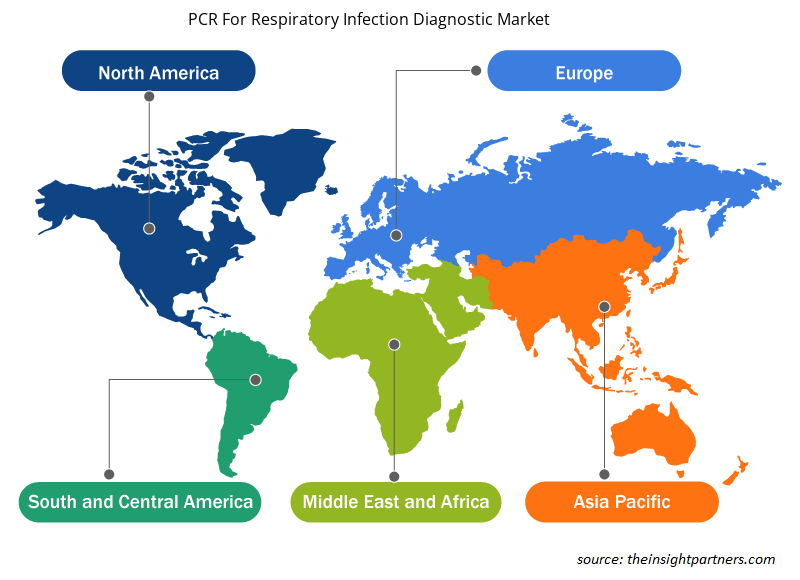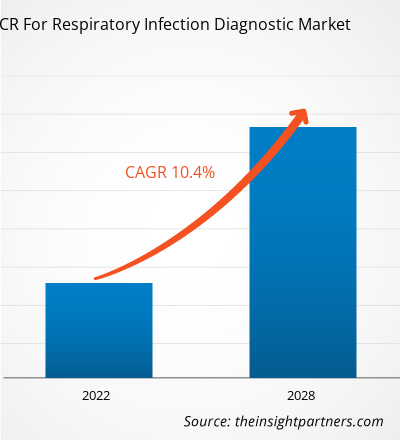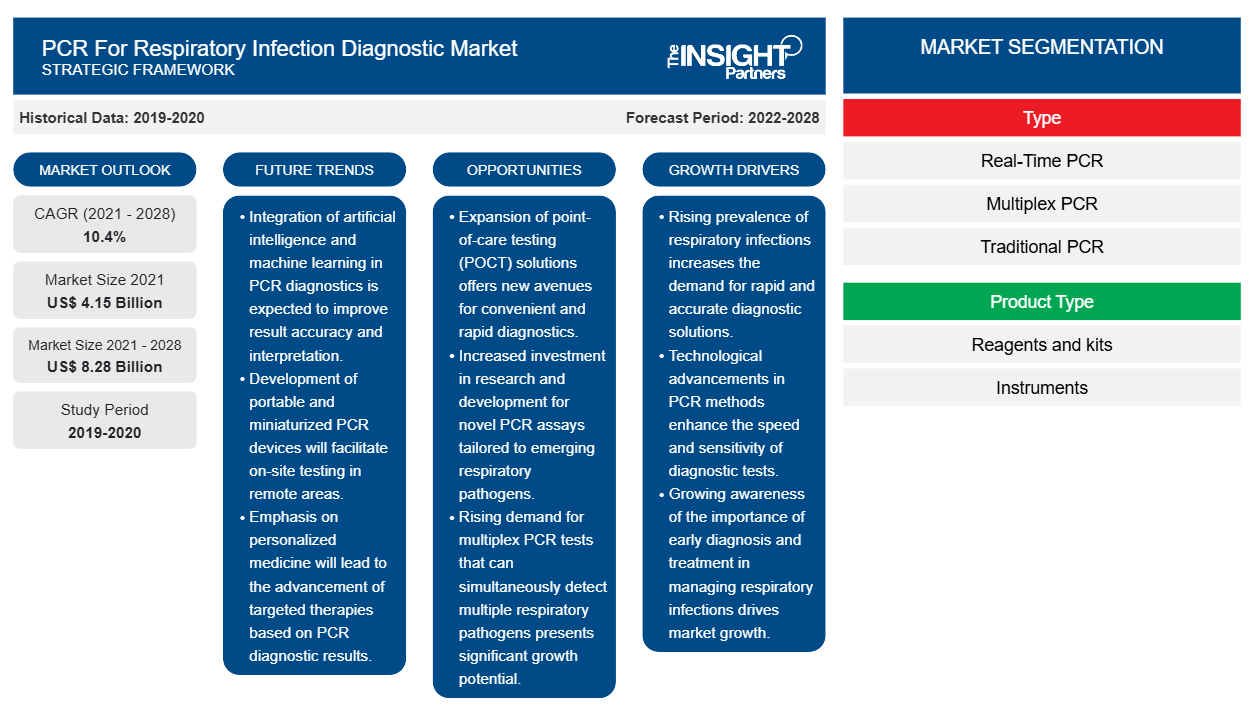Il mercato della PCR per la diagnosi delle infezioni respiratorie è stato valutato a 8.279,32 milioni di dollari entro il 2028, rispetto ai 4.146,02 milioni di dollari del 2021; si stima che crescerà a un CAGR del 10,4% dal 2021 al 2028.
La reazione a catena della polimerasi (PCR) è utilizzata per diagnosi accurate al punto di cura che aiutano a identificare e determinare rapidamente la causa delle infezioni del tratto respiratorio. Inoltre, la PCR è ampiamente preferita in contesti ospedalieri e ambulatoriali che aiutano a migliorare la crescita del mercato negli ultimi anni.
La crescita del mercato della PCR per la diagnostica delle infezioni respiratorie è attribuita a fattori quali il crescente carico di malattie respiratorie croniche (CRD), i crescenti sviluppi nei test PCR, stanno ampiamente migliorando le prestazioni dei dispositivi medici. Tuttavia, l'uso dei test PCR per varie diagnosi delle infezioni respiratorie e gli sviluppi nella tecnologia PCR utilizzata per derivarli. La disponibilità di test alternativi ostacola la crescita del mercato.
Personalizza questo report in base alle tue esigenze
Riceverai la personalizzazione gratuita di qualsiasi report, comprese parti di questo report, o analisi a livello nazionale, pacchetto dati Excel, oltre a usufruire di grandi offerte e sconti per start-up e università
-
Scopri le principali tendenze di mercato in questo rapporto.Questo campione GRATUITO includerà analisi di dati che spaziano dalle tendenze di mercato alle stime e alle previsioni.
Approfondimenti di mercato
Strategie di consolidamento del mercato adottate mediante l'uso del test PCR per varie diagnosi delle infezioni respiratorie
Il test PCR è il gold standard per la rilevazione di malattie infettive respiratorie, tra cui SARS-CoV-2. Inoltre, i crescenti sviluppi nel PCR non si limitano al test COVID-19. I continui sviluppi tecnologici hanno permesso ai ricercatori di sviluppare tecniche PCR avanzate a costi ridotti e di limitarne la complessità. Si prevede che il test PCR migliorerà le sue capacità di diagnostica molecolare e rafforzerà il suo ruolo in futuro con gli sviluppi in corso di tecnologie come la microfluidica e il sequenziamento di nuova generazione . Inoltre, il test PCR è utilizzato in modo significativo in istituzioni come case di cura, strutture di assistenza cronica e ospedali, per identificare l'infezione da virus influenzale che causa focolai respiratori.
Inoltre, le infezioni respiratorie acute e croniche sono tra le principali cause di morbilità nei paesi sviluppati e in via di sviluppo a livello globale. Si stima che le malattie respiratorie acute rappresentino quasi il 75% delle morbilità acute totali a livello globale. Pertanto, diverse aziende offrono vari kit PCR in grado di rilevare la presenza di agenti patogeni che causano malattie respiratorie. Ad esempio, aziende come bioMérieux SA e altona Diagnostics GmbH forniscono un'ampia gamma di kit PCR in grado di rilevare infezioni respiratorie acute nel tratto respiratorio superiore o inferiore. Oltre alla crescente incidenza di malattie respiratorie acute e croniche, altri fattori come le condizioni ambientali e climatiche, l'inquinamento atmosferico e le scoperte di nuovi batteri, virus e agenti patogeni probabilmente fungeranno da opportunità di crescita vitali per i test PCR per la diagnosi delle infezioni respiratorie nel prossimo futuro.
Informazioni basate sul tipo
Il mercato della PCR per la diagnostica delle infezioni respiratorie, per tipo, è segmentato in PCR in tempo reale (qPCR), PCR multiplex, PCR tradizionale, PCR digitale, trascrittasi inversa (RT-PCR) e altri. Il segmento della PCR in tempo reale (qPCR) ha detenuto la quota maggiore del mercato nel 2021 e si prevede che registrerà il CAGR più elevato nel mercato durante il periodo di previsione.
Informazioni basate sul tipo di prodotto
In base al tipo di prodotto, il mercato della PCR per la diagnostica delle infezioni respiratorie è segmentato in reagenti e kit, strumenti e altri. Il segmento reagenti e kit ha detenuto la quota maggiore del mercato nel 2021 e si prevede che registrerà il CAGR più elevato del mercato durante il periodo di previsione.
Informazioni basate sul tipo di infezione
In base al tipo di infezione, il mercato della PCR per la diagnostica delle infezioni respiratorie è segmentato in infezione batterica, infezione virale e patogeni fungini e di altro tipo. Nel 2021, il segmento delle infezioni virali ha detenuto la quota maggiore del mercato e si stima che registrerà il CAGR più elevato nel mercato durante il periodo di previsione.
Informazioni basate sugli utenti finali
In base all'utente finale, il mercato della PCR per la diagnostica delle infezioni respiratorie è segmentato in ospedali, cliniche mediche, laboratori clinici, istituti accademici e di ricerca, aziende biotecnologiche e farmaceutiche e altri. Nel 2020, il segmento dei laboratori clinici ha detenuto la quota maggiore del mercato e si stima che registrerà il CAGR più elevato del mercato durante il periodo di previsione.
I lanci e le approvazioni di prodotti sono le strategie comunemente adottate dalle aziende per espandere la loro presenza globale e i loro portafogli di prodotti. Inoltre, gli operatori del mercato della ricostruzione del seno si concentrano sulla strategia di collaborazione per ampliare la loro clientela, il che, a sua volta, consente loro di mantenere il loro marchio a livello globale.
PCR per le informazioni regionali sul mercato diagnostico delle infezioni respiratorie
Le tendenze regionali e i fattori che influenzano il mercato PCR For Respiratory Infection Diagnostic durante il periodo di previsione sono stati ampiamente spiegati dagli analisti di Insight Partners. Questa sezione discute anche i segmenti e la geografia del mercato PCR For Respiratory Infection Diagnostic in Nord America, Europa, Asia Pacifico, Medio Oriente e Africa e America centrale e meridionale.

- Ottieni i dati specifici regionali per il mercato diagnostico PCR per le infezioni respiratorie
PCR per l'ambito del rapporto di mercato diagnostico sulle infezioni respiratorie
| Attributo del report | Dettagli |
|---|---|
| Dimensioni del mercato nel 2021 | 4,15 miliardi di dollari USA |
| Dimensioni del mercato entro il 2028 | 8,28 miliardi di dollari USA |
| CAGR globale (2021 - 2028) | 10,4% |
| Dati storici | 2019-2020 |
| Periodo di previsione | 2022-2028 |
| Segmenti coperti |
Per tipo
|
| Regioni e Paesi coperti |
America del Nord
|
| Leader di mercato e profili aziendali chiave |
|
PCR per la densità degli operatori del mercato diagnostico delle infezioni respiratorie: comprendere il suo impatto sulle dinamiche aziendali
Il mercato PCR per la diagnostica delle infezioni respiratorie sta crescendo rapidamente, spinto dalla crescente domanda degli utenti finali dovuta a fattori quali l'evoluzione delle preferenze dei consumatori, i progressi tecnologici e una maggiore consapevolezza dei benefici del prodotto. Con l'aumento della domanda, le aziende stanno ampliando le loro offerte, innovando per soddisfare le esigenze dei consumatori e capitalizzando sulle tendenze emergenti, il che alimenta ulteriormente la crescita del mercato.
La densità degli operatori di mercato si riferisce alla distribuzione di aziende o società che operano in un particolare mercato o settore. Indica quanti concorrenti (operatori di mercato) sono presenti in un dato spazio di mercato in relazione alle sue dimensioni o al valore di mercato totale.
Le principali aziende che operano nel mercato della diagnostica PCR per le infezioni respiratorie sono:
- Abate
- F. Hoffmann-La Roche AG
- Azienda
- Società a responsabilità limitata Seegene Inc.
- Diagnostica Aus
Disclaimer : le aziende elencate sopra non sono classificate secondo un ordine particolare.

- Ottieni la panoramica dei principali attori del mercato della diagnostica delle infezioni respiratorie PCR
Per tipo
- PCR in tempo reale (qPCR)
- PCR multipla
- PCR tradizionale
- PCR digitale
- Trascrittasi inversa (RT-PCR)
- Altri
Per tipo di prodotto
- Reagenti e kit
- Strumenti
- Altri
Per tipo di infezione
-
Infezioni batteriche
- Bordetella
- Streptococco pneumoniae
- Stafilococco aureo
- Haemophilus influenzae
- Moraxella catarrhalis
- Micoplasma pneumoniae
- Chlamydophila pneumoniae
- Legionella
- Altri
-
Infezioni virali
- Rinovirus
- Virus dell'influenza
- Sindrome respiratoria acuta grave (SARS) Virus CoV-2
- Virus respiratorio sinciziale (RSV)
- Adenovirus
- Enterovirus
- Parainfluenza
- Metapneumovirus umano (hMPV)
- Altri
- Funghi e altri patogeni
Per utente finale
- Ospedali
- Cliniche mediche
- Laboratori clinici
- Istituzioni accademiche e di ricerca
- Aziende biotecnologiche e farmaceutiche
- Altri
Per Geografia
-
America del Nord
- NOI
- Canada
- Messico
-
Europa
- Francia
- Germania
- Regno Unito
- Spagna
- Paesi Bassi
- Norvegia
- Italia
- Resto d'Europa
-
Asia Pacifico (APAC)
- Cina
- India
- Giappone
- Australia
- Corea del Sud
- Resto dell'Asia Pacifica
-
Medio Oriente e Africa (MEA)
- Arabia Saudita
- Emirati Arabi Uniti
- Sudafrica
- Resto del Medio Oriente e Africa
-
America del Sud e Centro (SCAM)
- Brasile
- Argentina
- Resto del Sud e Centro America
Profili aziendali
- Abate
- F. Hoffmann-La Roche AG
- Azienda
- Società a responsabilità limitata Seegene Inc.
- Diagnostica Aus
- BD
- Laboratori Bio-Rad Inc.
- BioMérieux
- Qiagen
- Thermo Fisher Scientific Inc
- Analisi storica (2 anni), anno base, previsione (7 anni) con CAGR
- Analisi PEST e SWOT
- Valore/volume delle dimensioni del mercato - Globale, Regionale, Nazionale
- Industria e panorama competitivo
- Set di dati Excel
Report recenti
Testimonianze
Motivo dell'acquisto
- Processo decisionale informato
- Comprensione delle dinamiche di mercato
- Analisi competitiva
- Analisi dei clienti
- Previsioni di mercato
- Mitigazione del rischio
- Pianificazione strategica
- Giustificazione degli investimenti
- Identificazione dei mercati emergenti
- Miglioramento delle strategie di marketing
- Aumento dell'efficienza operativa
- Allineamento alle tendenze normative























 Ottieni un campione gratuito per - PCR per il mercato diagnostico delle infezioni respiratorie
Ottieni un campione gratuito per - PCR per il mercato diagnostico delle infezioni respiratorie